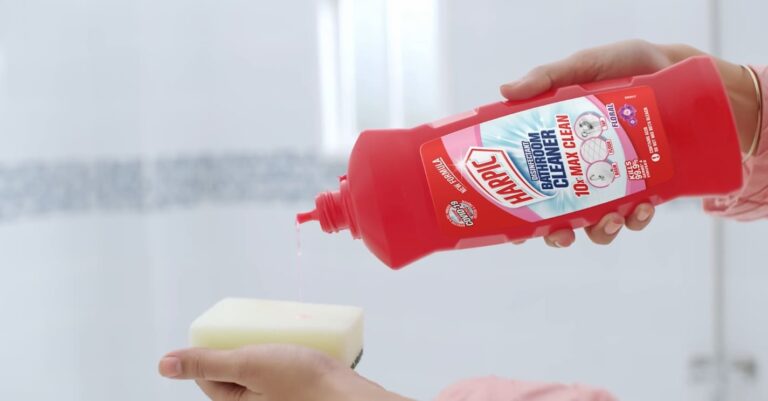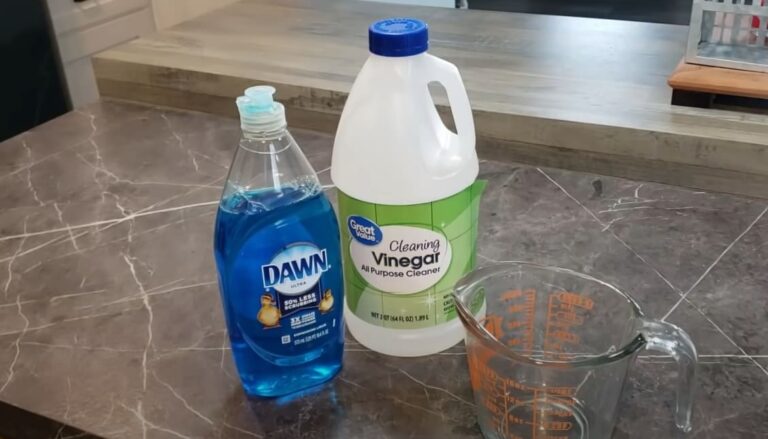Can You Mix Dish Soap and Baking Soda?
When it comes to cleaning the house, countless products are available to help tackle any mess. Two everyday household items are dish soap (dishwashing detergent) and baking soda (sodium bicarbonate), which many people keep on hand for various cleaning tasks. However, there’s often confusion about whether these two items can be mixed together to create a powerful cleaning solution or if doing so could be potentially harmful. In this article, we will explore the compatibility of dish soap and baking soda and provide insights into whether or not it’s safe and effective to mix them.
Dish Soap and Baking Soda: Can You Mix It?
Yes, you can mix dishwashing detergent and sodium bicarbonate together to create a cleaning solution. In fact, this combination is often used for various cleaning tasks around the house, such as scrubbing dishes, cleaning kitchen and bathroom surfaces, and removing stains from fabrics. The alkaline nature of sodium bicarbonate helps to break down grease and grime, while the dish soap acts as a surfactant to help lift and remove dirt and stains.
However, it’s important to note that not all dishwashing detergents are created equal, and some may contain harsh chemicals or fragrances that can react with sodium bicarbonate and cause unwanted results. Additionally, using too much baking soda can be abrasive and potentially damage surfaces, so it’s best to use caution and test a small area before applying the mixture to a larger surface.
Mixing dishwashing detergent and sodium bicarbonate can be a safe and effective cleaning solution, but it’s important to read the labels of the products you’re using and use them in moderation to avoid any negative consequences.

For What People Begin Mix Dish Soap With Baking Soda?
People begin to mix dishwashing detergent with sodium bicarbonate for various cleaning tasks around the house. The alkaline nature of sodium bicarbonate helps to break down grease and grime, while the dishwashing detergent acts as a surfactant to help lift and remove dirt and stains.
Some common cleaning tasks where people may mix dishwashing detergent with sodium bicarbonate include:
- Cleaning kitchen and bathroom surfaces: A mixture of dishwashing detergent and sodium bicarbonate can be an effective way to clean countertops, sinks, and other surfaces around the house.
- Removing stains from fabrics: Mixing dishwashing detergent and sodium bicarbonate can help remove stains from clothing, upholstery, and carpets.
- Scrubbing dishes: Adding sodium bicarbonate to dishwashing detergent can create a more effective solution for cutting through grease and grime on dishes.
- Cleaning appliances: A mixture of dishwashing detergent and sodium bicarbonate can be used to clean appliances like ovens, microwaves, and refrigerators.
Mixing dishwashing detergent with sodium bicarbonate can be a versatile and effective cleaning solution for a wide range of tasks.
Composition Of Baking Soda
Sodium bicarbonate has a chemical formula of NaHCO3. It is a white, crystalline powder that is slightly alkaline in nature. Sodium bicarbonate is composed of sodium ions (Na+), bicarbonate ions (HCO3-), and water molecules (H2O).
The pH of baking soda is around 8.3, which makes it a mild alkaline substance. When sodium bicarbonate is mixed with an acid, it undergoes a chemical reaction and releases carbon dioxide gas, which causes bubbles and makes the mixture foam. This reaction is commonly used in baking to help dough rise, but it also has various household and cleaning applications.
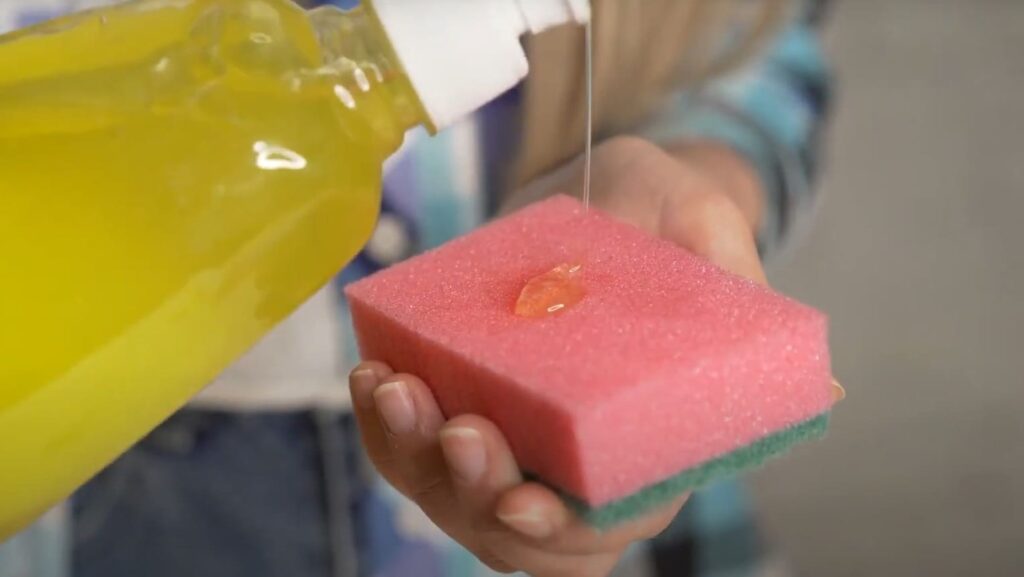
Sodium bicarbonate is considered safe for consumption and has many uses beyond baking, such as cleaning, deodorizing, and personal hygiene. However, it’s important to note that excessive consumption or inhalation of sodium bicarbonate can have harmful effects and should be avoided.
Composition Of Mixed Dish Soap With Baking Soda
The composition of mixed dishwashing detergent with sodium bicarbonate will depend on the specific products used and the proportions of each ingredient. However, in general, a mixture of dishwashing detergent and sodium bicarbonate will contain the active ingredients of both products.
Dishwashing detergent is typically composed of surfactants, which are compounds that help to reduce the surface tension of water and make it easier to lift and remove dirt and stains. Dishwashing detergents may also contain additional ingredients such as fragrances, dyes, and preservatives.
Sodium bicarbonate, as mentioned earlier, is composed of sodium ions (Na+), bicarbonate ions (HCO3-), and water molecules (H2O). When mixed with dishwashing detergent, the sodium bicarbonate can help to enhance the cleaning power of the dishwashing detergent by providing an alkaline environment that helps to break down grease and grime.
The specific composition of mixed dishwashing detergent with sodium bicarbonate will depend on the proportions of each ingredient used and the specific types of dishwashing detergent and sodium bicarbonate. It’s important to read the labels of the products you’re using and follow any instructions or precautions to avoid any negative consequences.
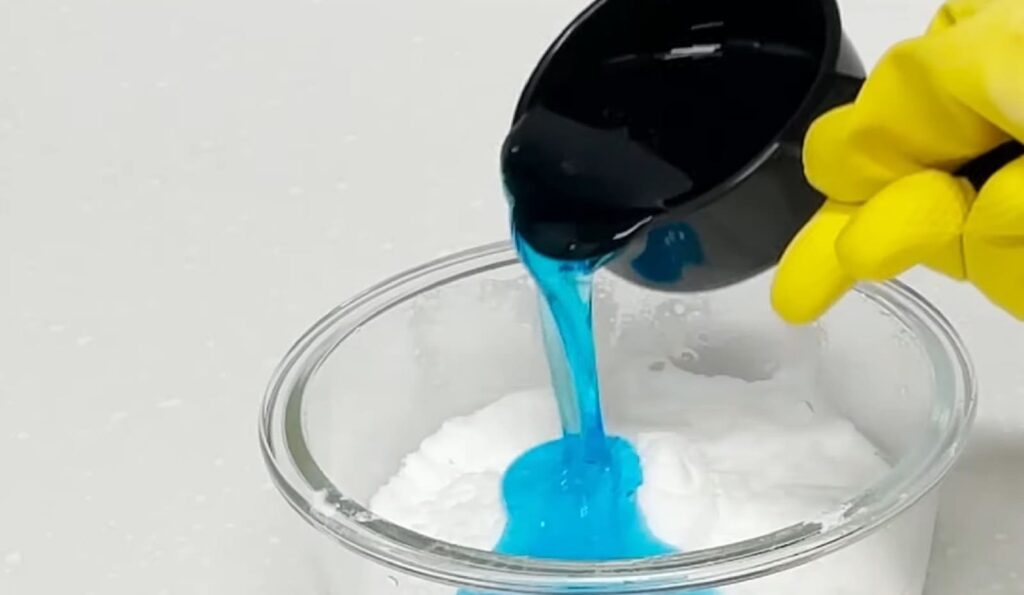
With What Else I Can Mix Dish Soap And Baking Soda?
There are several other ingredients that you can mix with dishwashing detergent and sodium bicarbonate to enhance their cleaning power and versatility. Here are a few options:
- Vinegar: Mixing vinegar with dishwashing detergent and sodium bicarbonate can create a powerful cleaning solution that can tackle tough stains and grease. The vinegar helps to dissolve mineral deposits and soap scum, while the dishwashing detergent and sodium bicarbonate provide a scrubbing action.
- Lemon juice: Adding lemon juice to a mixture of dishwashing detergent and sodium bicarbonate can help to remove stains and brighten surfaces. The acidity of the lemon juice can help to dissolve grime and dirt, while the baking soda provides a gentle scrubbing action.
- Hydrogen peroxide: Mixing hydrogen peroxide with dishwashing detergent and sodium bicarbonate can create a powerful stain remover. Hydrogen peroxide has strong oxidizing properties that can help to break down tough stains, while the dish soap and sodium bicarbonate provide a scrubbing action.
- Essential oils: Adding a few drops of essential oils, such as tea tree oil or lavender oil, to a mixture of dishwashing detergent and sodium bicarbonate can help to enhance their cleaning power and provide a pleasant scent.
It’s important to note that not all ingredients are compatible with each other and may react in a way that is harmful or less effective. It’s always best to do a small test before using any new mixture on a larger surface.
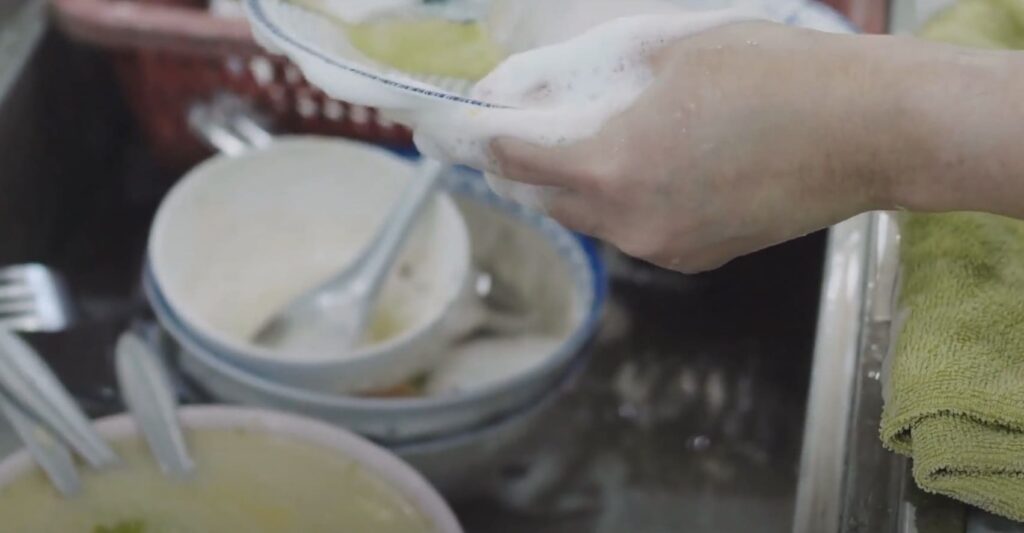
Advantages Of Mixing Dish Soap With Baking Soda
Mixing dishwashing detergent with sodium bicarbonate can have several advantages for cleaning tasks around the house. Here are a few benefits:
- Enhanced cleaning power: Sodium bicarbonate has a mild alkaline nature that helps to break down grease and grime, while dish soap acts as a surfactant to lift and remove dirt and stains. Together, they create a powerful cleaning solution that can tackle tough messes.
- Versatility: Mixing dishwashing detergent with sodium bicarbonate can be used for a wide range of cleaning tasks, from scrubbing dishes to cleaning appliances and surfaces. It’s a versatile solution that can replace the need for multiple cleaning products.
- Affordable: Dishwashing detergent and sodium bicarbonate are both inexpensive and readily available at most stores. Mixing them together can create an affordable and effective cleaning solution that doesn’t break the bank.
- Safe: Dishwashing detergent and sodium bicarbonate are generally considered safe for use around the house and don’t contain harsh chemicals that can be harmful to people or pets.
Mixing dishwashing detergent with sodium bicarbonate can provide a cost-effective and versatile cleaning solution that can tackle a wide range of cleaning tasks.
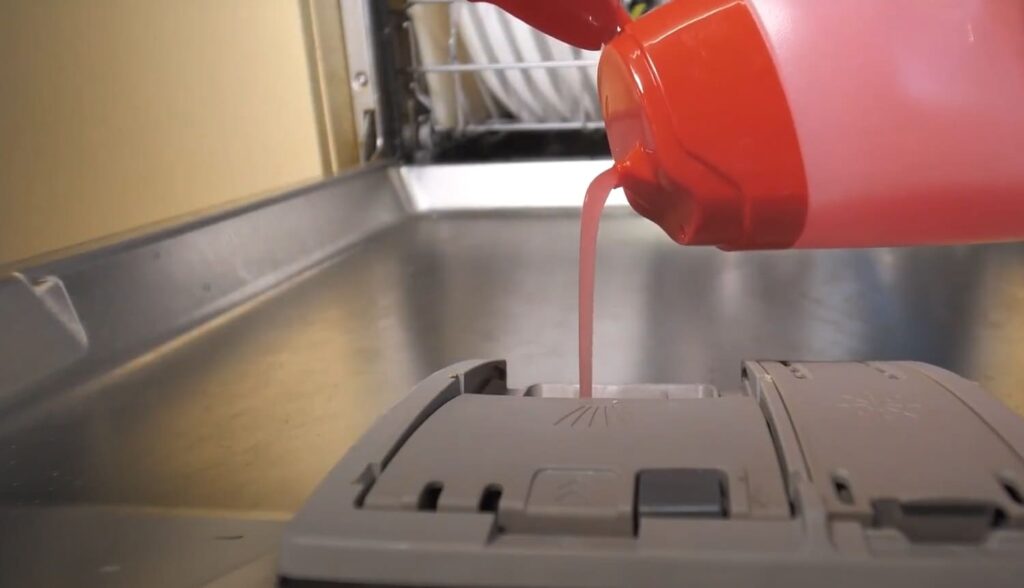
Disadvantages Of Mixing Dish Soap With Baking Soda
While mixing dishwashing detergent with sodium bicarbonate can have several advantages, there are also some potential disadvantages to consider. Here are a few:
- Residue: If the mixture is not rinsed off thoroughly, it can leave a residue behind that can be difficult to remove. This can make surfaces appear dull and streaky.
- Corrosive: Sodium bicarbonate is mildly abrasive and can be corrosive to certain surfaces, especially if used in high concentrations or applied with a rough scrubbing brush. This can cause damage to delicate surfaces such as marble or certain types of plastics.
- Foaming: The combination of dishwashing detergent and sodium bicarbonate can create a lot of foam, which can make it difficult to rinse off completely. This can lead to a buildup of soap scum over time, which can be difficult to remove.
- Limited effectiveness: While mixing dishwashing detergent with sodium bicarbonate can enhance the cleaning power of both ingredients, it may not be as effective for certain types of stains or dirt. For example, it may not be the best option for removing tough, set-in stains.
It’s important to always follow the instructions on the products you’re using and to test any new mixture on a small, inconspicuous area before using it on a larger surface. This can help to prevent any potential damage or negative effects.

FAQ
How dangerous is it to mix soap with baking soda?
Mixing dishwashing detergent with sodium bicarbonate is generally considered safe for household cleaning purposes and is not typically dangerous. However, there are a few things to keep in mind to ensure safe use:
- Avoid ingesting: Both dishwashing detergent and sodium bicarbonate are not meant for ingestion and can be harmful if ingested. It’s important to keep them out of reach of children and pets and to avoid using them near food or food preparation areas.
- Avoid contact with eyes: Dishwashing detergent can be irritating to the eyes, and baking soda can cause temporary irritation or discomfort. It’s important to avoid getting the mixture in your eyes and to rinse your eyes thoroughly with water if it does come into contact with them.
- Follow instructions: It’s important to follow the instructions on the products you’re using and to avoid using too much of either ingredient. Using too much sodium bicarbonate, for example, can cause surface damage or create an excessively alkaline solution.
- Avoid mixing with certain chemicals: Mixing dishwashing detergent and sodium bicarbonate with certain chemicals can create dangerous reactions. For example, mixing bleach with dish soap and baking soda can create toxic fumes. Always avoid mixing chemicals unless you are sure it is safe to do so.
While mixing dishwashing detergent with sodium bicarbonate is generally considered safe, it’s important to use common sense and follow precautions to ensure safe use.
How dangerous is baking soda?
Sodium bicarbonate is generally considered safe for household use and is not typically dangerous. However, there are a few things to keep in mind to ensure safe use:
- Ingestion: While sodium bicarbonate is safe to consume in small amounts, consuming large amounts can be harmful. This can cause stomach upset, nausea, and vomiting. It’s important to keep sodium bicarbonate out of reach of children and to avoid consuming it in large amounts.
- Allergies and sensitivities: Some people may be allergic or sensitive to sodium bicarbonate. This can cause skin irritation, hives, or other allergic reactions. It’s important to test any new product containing sodium bicarbonate on a small, inconspicuous area before using it on a larger surface.
- Corrosive: Baking soda is mildly abrasive and can be corrosive to certain surfaces, especially if used in high concentrations or applied with a rough scrubbing brush. This can cause damage to delicate surfaces such as marble or certain types of plastics.
- Interaction with other chemicals: Sodium bicarbonate can interact with certain chemicals and create potentially dangerous reactions. For example, mixing sodium bicarbonate with vinegar or other acids can create carbon dioxide gas, which can be dangerous if inhaled in large amounts.
Sodium bicarbonate is generally safe for household use, but it’s important to use common sense and follow precautions to ensure safe use.
How was baking soda created?
Sodium bicarbonate was first created in 1791 by a French chemist named Nicolas Leblanc. Leblanc discovered that carbon dioxide gas could be produced by heating a mixture of sodium carbonate (also known as soda ash) and acid. This process, known as the Leblanc process, was used to create soda ash, which was used in the production of glass and soap.
In 1846, two American bakers named John Dwight and Austin Church began producing sodium bicarbonate as a commercial product by reacting sodium carbonate with carbon dioxide gas. This process, known as the Solvay process, is still used today to produce sodium bicarbonate on a large scale.
Sodium bicarbonate quickly became popular as a household cleaning and cooking product due to its mild abrasive properties, ability to neutralize odors, and versatility in baking. Today, it’s widely used in households around the world for a variety of purposes, from cleaning and deodorizing to baking and cooking.
What shouldn’t baking soda be mixed with?
While sodium bicarbonate is generally safe to use, it’s important to be aware of certain substances that should not be mixed with it as they can cause potentially dangerous reactions. Here are some common substances that should not be mixed with sodium bicarbonate:
- Vinegar: Mixing vinegar with sodium bicarbonate creates carbon dioxide gas, which can cause a chemical reaction that results in a foamy eruption. This can be dangerous if inhaled in large amounts and can also cause skin irritation.
- Lemon juice: Similar to vinegar, lemon juice can react with sodium bicarbonate to produce carbon dioxide gas, which can result in a foamy eruption. This reaction can cause skin irritation and is also potentially dangerous if inhaled in large amounts.
- Acids: Mixing sodium bicarbonate with acids such as citric acid, tartaric acid, or hydrochloric acid can cause a chemical reaction that produces carbon dioxide gas. This can be dangerous if inhaled in large amounts and can also cause skin irritation.
- Bleach: Mixing sodium bicarbonate with bleach can create toxic chlorine gas, which can be very dangerous if inhaled. This reaction can also cause skin and eye irritation.
- Ammonia: Mixing sodium bicarbonate with ammonia can also create potentially dangerous fumes that can cause respiratory problems if inhaled. This reaction can also cause skin irritation.
It’s important to use sodium bicarbonate safely and to avoid mixing it with substances that can cause dangerous reactions. If you’re unsure about whether a substance can be safely mixed with sodium bicarbonate, it’s best to avoid mixing them.
For what unusual reason can I mix dish soap with baking soda?
While mixing dishwashing detergent with sodium bicarbonate is most commonly used for cleaning tasks around the house, there are a few unusual applications that you can try:
- Deodorizing shoes: Mix a small amount of sodium bicarbonate and dishwashing detergent with water to create a paste. Apply the paste to the inside of your shoes and let it sit for a few hours. Rinse the shoes with water and allow them to dry.
- Unclogging drains: Mix sodium bicarbonate and dishwashing detergent together, then pour the mixture down a clogged drain. Let the mixture sit for several minutes, then flush the drain with hot water.
- Removing stains from upholstery: Mix sodium bicarbonate and dishwashing detergent to create a paste, then apply it to the stained area on your upholstery. Use a soft-bristled brush to gently scrub the paste into the fabric, then let it sit for a few minutes before wiping it away with a damp cloth.
- Cleaning jewelry: Mix a small amount of sodium bicarbonate and dishwashing detergent with water to create a paste, then use a soft-bristled toothbrush to gently scrub your jewelry. Rinse the jewelry with water and dry it with a soft cloth.
It’s important to remember to always test any mixture on a small, inconspicuous area before using it on a larger scale to ensure that it doesn’t damage or discolor the surface.
For what else can I use baking soda?
Baking soda is a versatile household product that can be used for a variety of purposes. Here are some other ways you can use sodium bicarbonate:
- Cleaning: Sodium bicarbonate is a natural abrasive that can help remove stains and grime from a variety of surfaces, including sinks, countertops, and ovens. Mix sodium bicarbonate with water to create a paste, then use a soft cloth or sponge to clean the surface.
- Deodorizing: Sodium bicarbonate is an effective deodorizer that can help neutralize unpleasant odors around the house. You can sprinkle it on carpets, upholstery, and even in your shoes to absorb odors.
- Exfoliating: Sodium bicarbonate can be used as a gentle exfoliant for the skin. Mix baking soda with water to create a paste, then gently rub it onto your skin in circular motions before rinsing it off.
- Freshening the fridge: Placing an open box of sodium bicarbonate in the fridge can help absorb odors and keep the fridge smelling fresh.
- Soothing bug bites: Mix sodium bicarbonate with water to create a paste, then apply it to bug bites to help reduce itching and inflammation.
- Polishing silverware: Mix sodium bicarbonate with water to create a paste, then use a soft cloth to gently polish your silverware.
These are just a few examples of the many ways you can use sodium bicarbonate around the house. It’s an affordable and environmentally-friendly alternative to many commercial cleaning and personal care products.
For what else can I use dish soap?
Dishwashing detergent is a versatile cleaning product that can be used for a variety of purposes beyond washing dishes. Here are some other ways you can use dish soap:
- Cleaning surfaces: Dishwashing detergent is effective at cutting through grease and grime on surfaces like countertops, stovetops, and floors.
- Removing stains: You can use dishwashing detergent to remove stains from clothing, carpets, and upholstery. Simply apply a small amount of dish soap to the stain and blot it with a clean cloth.
- Washing pets: You can use mild dishwashing detergent to wash your pets. It’s important to use a soap that is formulated for pets and to rinse your pet thoroughly after washing.
- Cleaning makeup brushes: Mix a small amount of dishwashing detergent with water, then use it to clean your makeup brushes.
- Removing oil and grease from hands: Dishwashing detergent can effectively remove oil and grease from your hands after working on cars or other projects.
- Cleaning outdoor furniture: Dishwashing detergent can be used to clean outdoor furniture and remove dirt and grime from plastic, metal, and wood surfaces.
These are just a few examples of the many ways you can use dishwashing detergent around the house. It’s an affordable and effective cleaning solution that can be used in a variety of ways.
Related Video: How to Clean an Oven with Baking Soda, Dish Soap & Vinegar
Conclusion
Mixing dishwashing detergent and sodium bicarbonate can be a helpful solution for tackling tough cleaning jobs around the house. The mixture is particularly effective at removing stubborn stains and grease, and it’s also a cost-effective and environmentally-friendly cleaning option.
However, it’s important to use caution when mixing these two substances. While sodium bicarbonate is generally safe to use, it can interact with other chemicals to create potentially dangerous reactions. It’s important to avoid mixing sodium bicarbonate with substances like vinegar, bleach, and ammonia, as these can create toxic fumes or other harmful reactions.
If you’re unsure about whether a particular substance can be safely mixed with sodium bicarbonate, it’s best to avoid mixing them. With proper precautions and careful use, the mixture of dishwashing detergent and sodium bicarbonate can be a useful tool in your cleaning arsenal.


